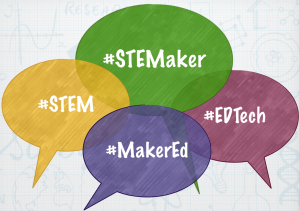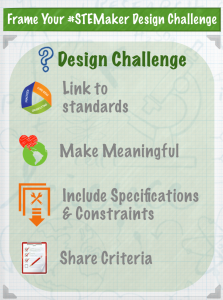 Over the past decade, our community spaces, such as schools, museums, youth centers, and even workplaces have been co-opted by a learning revolution. At work under multiple aliases, such as Design Thinking, STEM or STEAM, Makerspaces, and yes Hacking, this revolution has called for us to re-examine our notions of teaching and learning and reimagine a new approach to preparing learners of all ages to link learning to local change and global innovation. [clear] As this movement unfolds, the headlines
Over the past decade, our community spaces, such as schools, museums, youth centers, and even workplaces have been co-opted by a learning revolution. At work under multiple aliases, such as Design Thinking, STEM or STEAM, Makerspaces, and yes Hacking, this revolution has called for us to re-examine our notions of teaching and learning and reimagine a new approach to preparing learners of all ages to link learning to local change and global innovation. [clear] As this movement unfolds, the headlines
- predict our need for STEM careers in order to be globally competitive
- necessitate critical thinking (a byproduct of STEM learning, making, and design thinking) as a means to navigate daily life and civic choices
- call for the transformation of schooling into rigorous, relevant learning environments. (Note, this goes beyonds individual teachers and their classrooms and distributes the onus among decision-makers, such as administrators and policy makers.)
Whether or not this learning revolution is televised (or streamed via mobile devices), how will you change the narrative of your classroom to prepare learners for the 21st century?
[important title=”Designing a STEMaker Experience for Your Students”]Put on your “maker” hat and learn how to design a STEMaker experience that engages students in high-level thinking, integrates STEM content and practices, and generates solutions for real-world situations. In this session, you will collaborate to complete a quick hands-on design challenge, plan a standards-based STEMaker learning activity, and identify resources that will help you transform your classroom into a rigorous, relevant STEMakerspace![/important] In my session, participants engaged in several activities to help themselves and their students (re)imagine the possibilities of STEM; (re)create meaningful, real-world solutions, and (re)think products and processes. We sparked curiosity with experiential learning, Make something that matters with a “bag of stuff”, to demonstrate how a STEMaker experience can be low-cost and low-tech while maintaining high levels of engagement and of course, fun.
 Next, we grounded the STEMaker experience in learning frameworks, such as the Rigor/Relevance Framework and Next Generation Science Standards to illustrate how a series of standards-based learning activities can comprise a rigorous, relevant learning experience. coque iphone xr A recent survey reported that teachers want more professional development to help them implement STEM, specifically the engineering design cycle. They asked, so I answered with a few examples of engineering design cycles for all ages: Engineering is Elementary, Teach Engineering, and WISEngineering. The remainder of the presentation exemplified ways for teachers to implement the STEMaker design cycle in their classrooms. Participants eagerly brainstormed possible design challenges with the person next to them.
Next, we grounded the STEMaker experience in learning frameworks, such as the Rigor/Relevance Framework and Next Generation Science Standards to illustrate how a series of standards-based learning activities can comprise a rigorous, relevant learning experience. coque iphone xr A recent survey reported that teachers want more professional development to help them implement STEM, specifically the engineering design cycle. They asked, so I answered with a few examples of engineering design cycles for all ages: Engineering is Elementary, Teach Engineering, and WISEngineering. The remainder of the presentation exemplified ways for teachers to implement the STEMaker design cycle in their classrooms. Participants eagerly brainstormed possible design challenges with the person next to them.


Brave volunteers played in a quick round of “Yes, and . coque iphone x . coque iphone 8 . “ to model how to structure brainstorm or ideation activities, empowering students to build on each others’ ideas. Also check out Agency By Design thinking routines for maker education. Participants were urged to use digital tools, such as instaGrok, to scaffold research and to tap into local expertise through class visits or Skype sessions. coque iphone pas cher I also encouraged participants to be deliberate about inviting a diverse group of local experts into their classrooms as they will serve as role models to help students imagine their future selves. Connecting back to our opening design challenge, Make something that matters with a “bag of stuff”, I reminded participants that STEMaker learning can be low-cost and low-tech, and also asked them to consider using digital tools to document the process. [notice]Track our hashtag, #STEMaker, to view participants’ tweets during the session.[/notice] To close, I emphasized that evaluation and feedback were key to realizing the STEMaker design cycle as a learning experience. coque iphone pas cher When we expect students to revise their thinking, we neutralize the notion of taking risks, and normalize the actions to try, learn, and try again. It is then, that we begin to change the narrative of our classrooms and prepare learners for real life in the 21st century. PS Here’s a short list of the #STEMaker resources I shared with participants.

